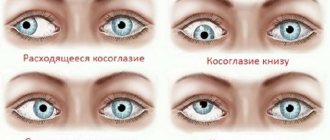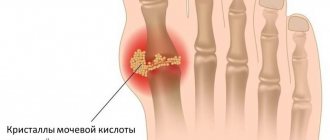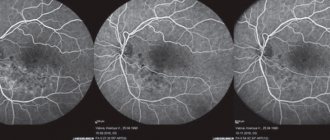Strabismus, or strabismus in scientific terms, is a pathological condition in which one or both eyes deviate from the point of fixation. In the early stages it is not always noticeable; if the form is advanced, it can lead to loss of vision.
It occurs in children and adults, less often in newborns (in the latter group there is a passing “false or imaginary strabismus” due to underdevelopment of the eye muscles).
The causes are varied: congenital and acquired strabismus occurs due to severe visual impairment, underdevelopment or pathology of the visual muscles, mental disorders and severe psychological trauma, some childhood diseases and other factors. Conservative methods are initially used for treatment; if they are ineffective, surgical intervention is used.
Causes
As a result of strabismus, or strabismus, one or both eyes do not concentrate on an object, and there is no complete picture of what is seen. Due to lack of coordination in the functioning of the eye muscles, the brain receives scattered ideas. Normally, in a healthy person, the eyes are fixed at a single point, the brain receives and forms a three-dimensional picture of what it sees.
The occurrence of the disease can be influenced by pathologies of the organ of vision, central nervous system, endocrine system, and mental disorders.
Factors provoking strabismus:
- eye injuries, tumors of the organ of vision;
- pathology of the development of muscle tissue that interferes with eye movement occurs in newborns and children whose mothers suffered from measles, scarlet fever, ARVI, cytomegalovirus and other infectious diseases during pregnancy;
- cataract;
- glaucoma;
- refractive error due to myopia or farsightedness;
- transformation of the vitreous body;
- fear in young children, severe psychological trauma;
- neurosyphilis, multiple sclerosis, encephalitis, blood flow disorders leading to paralysis of the eye muscles;
- increased intracranial pressure;
- pathological conditions in the brain or spinal cord leading to weakening of the eye muscles;
- Disturbances in the functioning of the endocrine system in pregnant women can lead to strabismus in the child.
Strabismus is not a hereditary pathology. Due to complicated heredity, the child may have farsightedness, myopia, and other refractive errors and eye function, which are a risk factor.
Classification
Depending on its occurrence, strabismus is of two types - congenital and acquired. The first type develops in a child while he is in the womb due to provoking factors.
The eyes have 12 extraocular muscles, and the left and right eyes have 6 muscles each. Each of them is responsible for turning the eyeball to the right, left, up or down. When the work of the extraocular muscles is uncoordinated and there is a lack of synchronization between them, strabismus is detected. Depending on the dysfunction of any of these muscles, the following types of strabismus occur:
- exotropia, or divergent strabismus;
- convergent (internal) strabismus;
- vertical strabismus;
- mixed form.
With exotropia, the eyes look “outward” and focus in different directions. The convergent form is also called isotropy. It is characterized by focusing the eyes in the opposite direction, on the bridge of the nose. With the vertical variety, squinting eyes are observed in a vertical plane - up or down.
Acquired strabismus can occur in one of three forms:
- constant;
- temporary due to alcohol intoxication or the effects of narcotic and psychotic substances, severe relaxation or illness;
- sensory – a harbinger of decreased vision.
Another classification of strabismus divides the disease into imaginary, hidden and true types. If the development of the oculomotor muscles of the right and left eyes is unequal, latent strabismus is diagnosed, which is noticeable when covering the healthy eye with a hand.
Concomitant strabismus
It is characterized by identical strabismus angles, insufficient development of the extraocular muscles of both eyes and the absence of double vision.
According to the mechanism of development, strabismus is divided into 3 subtypes: accommodative, partially accommodative and non-accommodative. In the first subtype, the disease is preceded by farsightedness, myopia and other accommodation disorders. Glasses are required for treatment. In the second subtype, partial vision loss is diagnosed. The non-accommodative type of strabismus is not easily identified and eliminated, since it occurs in the child at birth due to sudden injuries and blows suffered by the mother and infectious diseases.
The opposite of concomitant strabismus is the paralytic type, accompanied by double vision. It occurs due to the inability to move the eyes, leading to headaches, fatigue and general malaise, and partial or complete paralysis of the eye muscle tissue.
Symptoms
The main symptom of strabismus is the asymmetry of the iris and pupil to the palpebral fissure.
With paralytic strabismus, the eye cannot move towards the paralyzed muscle, or this movement is difficult. Associated symptoms: dizziness, diplopia, difficulty determining the distance to an object. The angle of deviation of a squinting eye is less than that of a healthy eye.
- Strabismus in newborns: causes, treatment methods and prevention
To compensate for the squinting eye, a person with paralytic strabismus turns or tilts their head. He has to do this so that the image of the object falls on the retina, and then double vision is not observed.
If the oculomotor nerve is damaged during strabismus, then dilation of the pupil, ptosis of the upper eyelids is observed, the eye deviates, and paralysis of accommodation may occur.
With concomitant strabismus, there are no differences in the angles of the squinting and healthy eyes, the muscles work normally. Conjugate strabismus is divided into convergent and divergent, torsional, vertical, combined, monocular and alternating. Monocular strabismus leads to disruption of the functioning of the squinting eye, while vision decreases and amblyopia develops.
Imaginary strabismus
This type occurs in newborns and can persist for up to 4 months due to the underdevelopment of the optic nerve and the inability to focus the gaze. It does not require observation or correction.
To develop the eye muscles, it is necessary to show the child objects of predominantly black and white colors, from a month - green and yellow colors at a distance of 15-20 cm. After focusing the gaze on the object, it should be slowly moved to the sides, up or down.
If the condition persists after 4 months, a visit to an ophthalmologist is required.
Surgery to correct strabismus
In most cases, the only effective treatment for persistent strabismus is strabismus surgery.
If your child's eye doctor finds that your child has a squint, he or she may refer you to an ophthalmologist who specializes in surgery to correct strabismus.
The success of surgery to correct strabismus depends on many factors, including the direction and degree of misalignment of the eye. In some cases, multiple surgeries may be required. The surgeon performing strabismus surgery will provide you with more information about this during your preoperative consultation.
This type of strabismus surgery can also be effective for adults with long-standing strabismus. However, in many cases of adult strabismus, a significant degree of amblyopia may persist even after proper alignment of the misaligned eye. This is why early treatment of strabismus is so important.
The earlier surgery is performed, the more likely it is that the affected eye will develop normal visual acuity and both eyes will function smoothly.
Diagnostics
To diagnose strabismus, it is necessary to collect an anamnesis, the timing of the onset of the disease, and establish a connection between strabismus and previous or existing diseases. Biometric studies, a test ophthalmological examination, a refractive examination are carried out and the ophthalmologist examines the structures of the eye.
When making a diagnosis, the angle of strabismus is measured and the volume of accommodation is determined. If a paralytic type of pathology is diagnosed, additional consultation with a neurologist and a computer examination is required.
Treatment
Strabismus therapy is aimed at restoring normal, binocular vision. It includes several methods. With successful treatment, stable binocular vision, high visual acuity, and symmetry of eye position are restored.
Correction with glasses and lenses
Necessary for any type of strabismus. Especially with accommodation, when the provoking factor for the disease was myopia, farsightedness or other accommodation disorders.
The purpose of optical correction with the help of selected contact lenses or glasses is to restore visual acuity, eye similarity and accommodation.
Hardware treatment
Using special devices, the visually impaired or amblyopic eye is stimulated. Computer programs, Synoptophore, photo, laser and magnetic stimulation, Amblyocor, vacuum ophthalmic massage are common.
Wearing an occlusive dressing
A special bandage is fixed on the healthy eye, the person sees objects with a squinting eye. This is done with the aim of increasing the load on the pathological eye, excluding the fixing, healthy eye from the vision process. Hardware treatment and the use of special computer programs are based on this principle.
Surgery
A treatment option if conservative treatment for a year and a half has not produced positive results and improvement in the patient’s condition. The most optimal age for surgical intervention is 3-5 years. First, the tendon is cut or a muscle is transplanted to weaken muscle regulation, then in the second stage the action of the extraocular muscle is strengthened by shortening it.
The disadvantage of surgical treatment is the possibility of complications (poor vision and blindness, bleeding, infection, insufficient or excessive correction of strabismus).
Expert opinion
Kiryukhina Svetlana Lvovna
Ophthalmologist of the highest category in the children's department, ophthalmic surgeon, Candidate of Medical Sciences
Treatment of strabismus is a long process, and surgical treatment alone is not enough. It is not enough to return the eye to the correct position, you need to teach the body how to use it correctly. This is achieved by regular training: visual gymnastics, development and consolidation of binocular vision, correction of amblyopia.
And while it is still possible to explain to an adult the need for regular exercise, children quickly get bored with it. In this case, the success of treatment depends on the parents, who must monitor the implementation of all prescriptions of the attending physician.
Cost of basic services
| Service | Price, rub.) | By map |
| Therapeutic programs | ||
| Conservative treatment of refractive errors (5 sessions) ? A course of hardware and physiotherapeutic procedures aimed at treating myopia, farsightedness, and astigmatism. | Price 5750 ₽ | By map 5250 ₽ |
| Conservative treatment of refractive errors (10 sessions) ? A course of hardware and physiotherapeutic procedures aimed at treating myopia, farsightedness, and astigmatism. | Price 11500 ₽ | By map 10500 ₽ |
| Pleoptic treatment (10 sessions) ? A course of hardware treatment aimed at increasing the sharpness of the worse-seeing eye. | Price 15900 ₽ | By map 14800 ₽ |
| Pleoptic treatment (5 sessions) ? A course of hardware treatment aimed at increasing the sharpness of the worse-seeing eye. | Price 7950 ₽ | By map 7400 ₽ |
| Orthoptic treatment for younger age group (10 sessions) ? A course of hardware treatment aimed at improving the joint functioning of the eyes. For patients under 6 years of age | Price 15900 ₽ | By map 14800 ₽ |
| Orthoptic treatment for younger age group (5 sessions) ? A course of hardware treatment aimed at improving the joint functioning of the eyes. For patients under 6 years of age | Price 7950 ₽ | By map 7400 ₽ |
| Orthoptic treatment for older age group (10 sessions) ? A course of hardware treatment aimed at improving the joint functioning of the eyes. For patients over 6 years old | Price 17800 ₽ | By map 16600 ₽ |
| Orthoptic treatment for older age group (5 sessions) ? A course of hardware treatment aimed at improving the joint functioning of the eyes. For patients over 6 years old | Price 8900 ₽ | By map 8300 ₽ |
| Pleopto-orthoptic treatment younger age group (10 sessions) ? A course of hardware treatment aimed at restoring binocular function with changes in the nature of vision and treating amblyopia. For patients under 6 years of age | Price 17100 ₽ | By map 16000 ₽ |
| Pleopto-orthoptic treatment younger age group (5 sessions) ? A course of hardware treatment aimed at restoring binocular function with changes in the nature of vision and treating amblyopia. For patients under 6 years of age | Price 8500 ₽ | By map 8000 ₽ |
| Pleopto-orthoptic treatment, older age group (10 sessions) ? A course of hardware treatment aimed at restoring binocular function with changes in the nature of vision and treating amblyopia. For patients over 6 years old | Price 18800 ₽ | By map 17400 ₽ |
| Pleopto-orthoptic treatment older age group (5 sessions) ? A course of hardware treatment aimed at restoring binocular function with changes in the nature of vision and treating amblyopia. For patients over 6 years old | Price 9400 ₽ | By map 8700 ₽ |
| Orthoptic-diploptic treatment (10 sessions) ? A course of hardware treatment aimed at restoring binocular function in patients with a minimal angle of strabismus. For patients over 6 years old | Price 19000 ₽ | By map 18000 ₽ |
| Orthoptic-diploptic treatment (5 sessions) ? A course of hardware treatment aimed at restoring binocular function in patients with a minimal angle of strabismus. For patients over 6 years old | Price 9500 ₽ | By map 9000 ₽ |
| Comprehensive vision activation program (10 sessions) ? A course of hardware treatment aimed at improving the blood supply to the eye and activating the work of the central parts of the visual analyzer. | Price 19200 ₽ | By map 17800 ₽ |
| Comprehensive vision activation program (5 sessions) ? A course of hardware treatment aimed at improving the blood supply to the eye and activating the work of the central parts of the visual analyzer. | Price 9600 ₽ | By map 8900 ₽ |
| Program "MAXIMUM" (10 sessions) ? The most effective course of hardware and physiotherapeutic treatment, selected individually according to medical indications | Price 23000 ₽ | By map 21800 ₽ |
| Program "MAXIMUM" (5 sessions) ? The most effective course of hardware and physiotherapeutic treatment, selected individually according to medical indications | Price 11500 ₽ | By map 10900 ₽ |
| “MAXIMUM” program with orthoptic slope (10 sessions) ? The most effective course of hardware and physiotherapeutic treatment, selected individually according to medical indications for patients with impaired binocular vision | Price 23500 ₽ | By map 22200 ₽ |
| “MAXIMUM” program with orthoptic slope (5 sessions) ? The most effective course of hardware and physiotherapeutic treatment, selected individually according to medical indications for patients with impaired binocular vision | Price 11750 ₽ | By map 11100 ₽ |
| Postoperative course of orptoptic treatment for patients operated on for strabismus in other clinics (10 sessions) ? A course of hardware treatment after surgery for strabismus. | Price 28200 ₽ | |
| Orthoptic course of treatment (stage II) (10 sessions) ? A course of hardware treatment after surgery for strabismus. | Price 9700 ₽ | By map 9100 ₽ |
| Orthoptic course of treatment (stage II) (5 sessions) ? A course of hardware treatment after surgery for strabismus. | Price 4850 ₽ | By map 4550 ₽ |
| Treatment with the “Rucheek” device (10 sessions)? The device is used to train the accommodation mechanism | Price 6400 ₽ | By map 6050 ₽ |
| Treatment with the “SINOPTOPHOR” device (10 sessions)? The device is used in a complex of therapeutic training for strabismus. | Price 14150 ₽ | By map 13200 ₽ |
| Treatment with the FORBIS device (10 sessions)? The device is used to train the accommodation mechanism and restore binocular vision. | Price 14150 ₽ | By map 13200 ₽ |
| Treatment with the REAMED device (10 sessions)? The device allows you to normalize the functioning of the central parts of the brain responsible for vision, for the prevention and treatment of spasms of accommodation, amblyopia, and refractive errors. | Price 10600 ₽ | By map 9900 ₽ |
| Postoperative treatment course, 10 sessions | Price 8900 ₽ | |
| Postoperative treatment course, 5 sessions | Price 4450 ₽ | |
| Course of postoperative treatment, 1 session | Price 890 ₽ | |
| Treatment of strabismus | ||
| Surgical treatment of strabismus, stage 1 (when performing surgery on one eye)? Surgical treatment of strabismus is used in cases where conservative methods fail to achieve symmetrical position of the eyes. The first stage is aimed at reducing the angle of strabismus. | Price 64500 ₽ | By map 60500 ₽ |
| Surgical treatment of strabismus, stage 1 (when surgery is performed on both eyes)? Surgical treatment of strabismus is used in cases where conservative methods fail to achieve symmetrical position of the eyes. The first stage is aimed at reducing the angle of strabismus. | Price 60000 ₽ | By map 56000 ₽ |
| Surgical treatment of strabismus, stage 2 (when performing surgery on one eye)? Surgical treatment of strabismus is used in cases where conservative methods fail to achieve symmetrical position of the eyes. The first stage is aimed at completely eliminating strabismus. | Price 30000 ₽ | By map 27000 ₽ |
| Surgical treatment of strabismus, stage 1 (when surgery is performed on both eyes), operating surgeon D.M.N., Professor K.B. Pershin | Price 121000 ₽ | By map 117300 ₽ |
| Surgical treatment of strabismus, stage 2, (when performing surgery on one eye), operating surgeon D.M.N., Professor K.B. Pershin | Price 60500 ₽ | By map 58600 ₽ |
| Surgical treatment of strabismus of high complexity | Price 115000 ₽ | By map 107000 ₽ |
| Surgical treatment of PARALYTIC strabismus? Surgical treatment of paralytic strabismus is used in cases where conservative methods fail to achieve symmetrical eye position. | Price 105000 ₽ | By map 99000 ₽ |
Full price list The cost of microsurgical operations is indicated for one eye
Full price list
Prevention
To prevent the development of strabismus in an adult or child, before planning a pregnancy, it is important to be examined, identify the presence of ophthalmological diseases and correct the condition. Do not be in areas of epidemics during the season of colds, flu, or other infectious diseases.
One of the preventive measures is regular visits to the doctor for examination.
If strabismus is detected, it is important not to be shy, adhere to the prescribed treatment, and perform gymnastics to strengthen and move the extraocular muscles. For example, look into the distance, then examine objects in the distance, draw a bow, a Christmas tree, or other objects with your gaze.
To hide squint, women can learn makeup techniques that don't focus on the eyes.
How it manifests itself
One of the main signs of strabismus is the appearance of the eyes, but it is not always reliable, since in children in the first year of life the strabismus is imaginary. Strabismus in children of the first year of life can be considered true only if one eye is constantly deviated to the side; this may indicate paralytic strabismus.
When this sign appears, you need to pay attention to the position of the child’s head, it will be forced. The child will constantly keep his head on his side or turn it to the side, this will compensate for the split image, decreased vision, headache, and the child may squint.
Useful video
The video tells who is more likely to experience strabismus, what visual features are observed, and how others treat them.
Author's rating
Author of the article
Alexandrova O.M.
Articles written
2100
about the author
Was the article helpful?
Rate the material on a five-point scale!
( 2 ratings, average: 3.00 out of 5)
If you have any questions or want to share your opinion or experience, write a comment below.




![Rice. 2. Relationship between dose of diclofenac (D), naproxen (Nap) and etoricoxib (Eto) and effect size in osteoarthritis [3]](https://ms-pi.ru/wp-content/uploads/ris-2-zavisimost-mezhdu-dozoj-diklofenaka-d-naproksena-nap-i-330x140.jpg)




